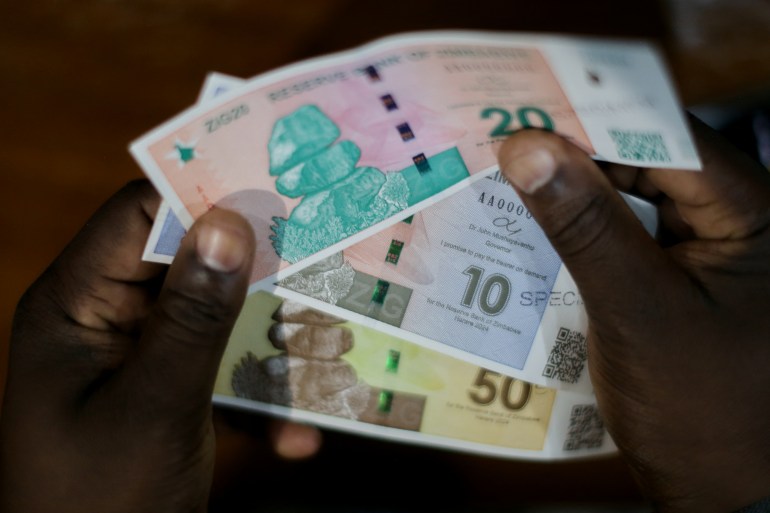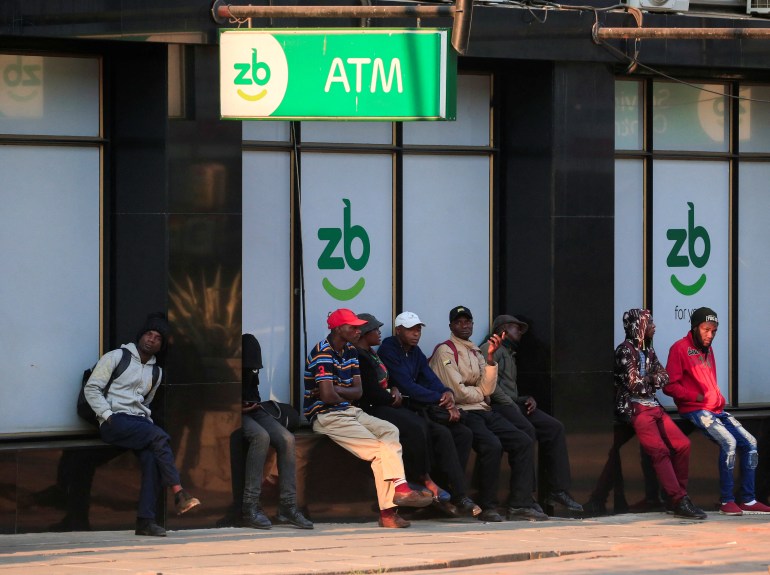The price tag said US$3.70. With Zimbabwe’s volatile currency and years of economic crisis, most goods are priced in more stable United States dollar amounts with customers receiving their small change in local currency.
Mutiri handed the shopkeeper four US$1 bills and waited for his change. But the shop had none available. The 37-year-old then tried to pay the full amount in ZWL, Zimbabwe’s outgoing currency, which locals call bond notes, but the till operator refused to accept it, telling him to buy something else or forfeit the balance.
The scenario is one many Zimbabweans now face on a daily basis since the country launched its new currency, Zimbabwe Gold, or ZiG, two weeks ago, Mutiri said, lamenting how people have to budget more for basics just to make it through the day.
On April 5, Zimbabwe’s central bank announced the new gold-backed currency, immediately implementing changes on digital platforms with local banks converting ZWL to ZiG amounts on their systems.
However, the new bank notes will become available only at the end of the month after the central bank’s governor put in place a grace period to enable the transition. In the meantime, the central bank made assurances that bond notes would still be in use.
Despite this, many businesses like the shop in Glenview have already ceased trading in ZWL, significantly impacting millions who depend on cash for their daily needs, including people working in the informal economy.

“This comes at a time when we are already struggling with unemployment and the drought. Shops cannot give change, meaning they are rounding up all the transactions,” Mutiri said.
“They are profiteering a lot during this period of poorly coordinated currency transition. One has to double or triple the usual spending,” he told Al Jazeera.
Old notes not accepted
The ZiG is set to replace both existing ZWL bond notes and the Zimbabwean dollar, launched in 2016 and 2019, respectively.
Zimbabwe has been struggling with its currency for more than a decade. The ZiG is the country’s sixth attempt to launch a new one since 2008 when the rate of inflation reached 79.6 billion percent per month before soaring to an unprecedented level of 89.7 zillion percent by November that year, according to the International Monetary Fund.
The decision to move to the ZiG was an attempt to tackle inflation and also foster “simplicity, certainty [and] predictability” in Zimbabwe’s financial affairs, John Mushayavanhu, the governor of the Reserve Bank of Zimbabwe, said at the launch.
But simplicity is not what many consumers in Zimbabwe are currently experiencing.
Several people in Harare and nearby towns and rural areas told Al Jazeera that despite assurances the old notes were still in use this month, government entities and the private and informal sectors were all rejecting them, leaving people in the lurch.
“This is beyond the shops. Last week at the tollgate, the government agency ZINARA was rejecting the bond notes, yet people do not have the ZiG cash,” Mutiri said, explaining how the agency insisted on US dollar payments at the tolls, resulting in a long queue as motorists protested but without success.
“Bond notes are still a legal tender for transactions, at least until April 30. The government itself is expected to reflect confidence and lead exemplarily, but they are also rejecting it altogether,” he added.

People were also unable to use online platforms to pay for telecommunications and electricity services in the immediate wake of the changeover while some banking services temporarily went offline from April 5 to 8, local media reported. This also affected US dollar transactions.
Clara Choti from the suburb of Kuwadzana said transport was now more expensive because operators were taking advantage of the situation.
“Local destinations within our suburbs where we used to pay between 30 and 50 [US] cents are now priced at $1, unless you are travelling as two or three people, which is rare. Operators say they do not have the change,” she said.
According to Craig Nhodo, a financial expert: “All these efforts by the government to change currencies are in search of stability of a freefall economy. [But] without the government itself committed to the use of the local currency, currencies have failed.
“Now ZiG is here, but you can’t buy fuel, pay import duty with it. Already the new currency is set for failure.”
‘It’s painful’
In rolling out the ZiG, Mushayavanhu said the central bank would organise campaigns to educate people about the new currency and its security features.
However, many people, especially those far from urban centres, are concerned.
In Murewa, a rural area 90km (55 miles) east of the capital, Agnes Kwaramba is worried about the lack of consultation done before the launch. The 61-year-old does not feel very confident about the ZiG in general.
Kwaramba, who retired five years ago, lost her savings four times during her career as a teacher. She said her losses were connected with changes in the currency rather than other economic factors bedevilling Zimbabwe.
“In 2001, 2008, 2016 and 2019, I lost my savings after decades of working, saving in anticipation of my retirement,” she told Al Jazeera. ”The monetary policies have failed us for years. Even now, there was no proper messaging and education to the populace about the new currency.”

When in 2016 the central bank introduced the ZWL as legal tender, it set the bank rate 1:1 to the US dollar and assured the nation that the value would be equivalent. So people, including Kwaramba, left money in their bank accounts only to realise the local currency was depreciating. Just a few months into the ZWL, millions had lost the value of their savings. Kwaramba’s finances have not recovered.
Again in 2019 when the Zimbabwe dollar was launched during runaway inflation, Zimbabwe faced another bleak period when foreign currencies, including the US dollar, were banned until 2020.
This time with the ZiG, Kwaramba said elderly people in rural areas are left with bond notes while shops refuse to give them change for their US dollars.
“The shops are not accepting our own currency, and when buying foodstuffs, they have no change,” Kwaramba lamented.
“Imagine here in the countryside amidst the El Nino-induced drought – it’s painful. We are failing to buy some of the basics due to the inflated prices or being forced to buy other goods.”
She said the government should have deployed Reserve Bank officers around the country to help allocate ZiG digital currency to use for mobile transactions while people wait for cash.
Lack of confidence or timing?
The Reserve Bank has assured the nation that the ZiG is backed by gold and is strong compared with the ZWL. But people like Mutiri and Kwaramba vividly remember the hope and eventual disappointment of prior currency swaps.
“We cannot be fooled again,” Kwaramba said. “I have spent my life as a civil servant, but I cannot point to anything today. After prices, this will go and affect our already paltry pensions.”
Economists said the 2016 launch of the bond notes was not informed by economic fundamentals and lack of political will in enforcing the use of that currency resulted in it failing and depreciating.
Economist Tashinga Henry Kajiva said the rationale behind the launch of the ZiG this year is mainly to curb inflation and introduce a medium of exchange stable enough to facilitate domestic and foreign trade.
But he added that the context is unfortunately wrong.

“The idea itself is normal. If you have a gold standard, a currency backed by actual physical precious minerals, it means it would introduce price stability, increasing investor confidence, because they are actually backed up by precious minerals.”
While the initiative was advantageous to a certain extent, Kajiva said, the ZiG is not being launched in the right context because there are fundamental issues that need to be addressed within the financial sector for it to succeed.
“The first thing that the government of Zimbabwe through the Reserve Bank and the Ministry of Finance have to address is consumer confidence stakeholders. Zimbabweans are not confident in the domestic currency,” Kajiva added.
“We know Zimbabwe’s economic history has been marred by hyperinflation, no policy consistency when it comes to the financial sector. All those things have eroded the public trust, and the government needs to be very proactive and instil confidence in this newfound currency.”
The currency challenges have been visible even before the launch of the ZiG, so much so that Zimbabweans have stuck with the US dollar, which they draw out at banks or money exchanges, get via remittances from abroad or buy on the informal market, relegating their local currency merely to money for “change”.
Kajiva noted that fuel, excise duties and key commodities being paid using the US dollar have further limited public trust in the new currency.
“If some of them are being bought using the US dollar, what it creates is a necessity of the US dollar to the average citizen or to the public or to the stakeholders. And what then happens is when you cannot get the proper amount of US dollar within the banking sector, within the formal channels, what will happen is people will resort to going to the informal market to have those monies changed,” Kajiva said.
Nevertheless, the US dollar is in Zimbabwe to stay. Governor Mushayavanhu said at the ZiG launch that the government would not stop its use of the greenback as a medium of exchange, even with the introduction of the new currency.
